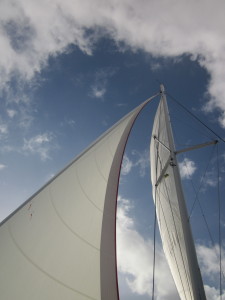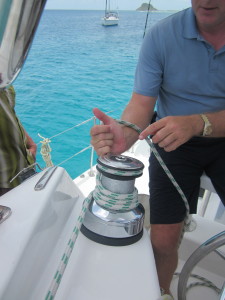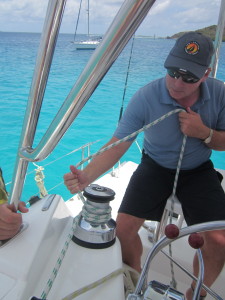The Windward Islands in the Caribbean offer some of the best sailing in the world! The Trade Wind breezes are steady and consistent. Sailing here is amazing – but it can be challenging. Proper winch technique is important for managing your sails in various conditions on a sailboat. It allows you to pull in sails smoothly and let sails out under control even under extreme pressure from the wind. However, you have to show some respect to the winch, as well as to yourself, by using it correctly. We teach safe and proper winch techniques during our live aboard Caribbean Sailing School courses. Here’s a preview:
PREPARING TO WORK THE WINCH
Secure hair, clothing or any loose objects that might get caught in the winch.
Pre-load the winch by putting two or three wraps on the winch using a fist, pinky pointed down the line.
Decide whether to use two or three wraps for your pre-load based on the amount of wind. Less wraps is better for your pre-load because the more wraps you wind on the winch barrel, the more chance there is of getting an override. An override can usually be prevented by pulling at a slight upward angle rather than a downward angle
Holding the line with your pinky pointed down helps to keep your hand from getting caught in the winch if you should get bumped, jarred or fall into the winch. Your hand is designed to let go easier if you are holding with your pinky pointed down.
If you need extra grip, you can twist your hand and gain a better grip on the line. NEVER wrap the line around your hand.
LOADING THE WINCH
Wind the winch in a clockwise direction.
You will hear a ratcheting sound as you pull in on the line when it is wound correctly.
Stay clear of the winch when winding the wraps so your fingers don’t get caught in the line.
Wind the line starting at the base of the barrel working up then follow the guide up into the self-tailer ring and give it a tug to secure it.
The self-tailer allows you to crank the winch without having to tail the line. Otherwise, you will have to hold the line taut and wind at the same time or have someone else tail for you.
USING THE WINCH HANDLE
With one hand, grasp the winch handle toward the end and fit it into the winch. MAKE SURE the handle is fully seated or it could slip out and cause you to crash into the winch! (Remove with one hand, also.)
Many winches have two-speeds – one way is faster and can be harder to winch; the other way is easier but slower.
Using one hand toward the base of the handle helps to prevent the handle from getting jammed as you try to remove it.
Always remove the winch handle and put it back in its proper place when you are finished adjusting the line. You will always know exactly where it is when you need it again
REMEMBER: Winch handles are water-seeking devices!
During a tack, the jib trimmer will be releasing the jib sheet allowing the jib to cross to the other side.
As the skipper calls “Ready to tack?”, you remove the line from the self-tailer and reply “Ready” still holding tension on the line. Don’t let it slip and don’t remove any of the wraps from the winch barrel. (Friction from the wraps on the winch barrel will help you control the load of the sail.)
As the jib just begins to luff, quickly remove all the wraps from the winch and watch to make sure the line doesn’t get fouled.
Once it goes across, pre-load the winch for the next tack.
BRINGING THE JIB BACK ACROSS
When you bring the line back across during a tack, have two or three “pre-load” wraps on the winch and make your pulls long and fast.
Remember to still use your “pinky side down” grip.
Pre-load the lazy jib sheet with two or three wraps.
Never lock the lazy sheet into the self-tailor when “pre-loading” it.
ALWAYS be thinking about what your next action might be!
Is the line ready to run free if needed? Does the main need to come in or be let out? How’s the jib trim? Are the lines ready and running fair?To learn more about proper winch technique, consider taking a sailing course from LTD Sailing. You can Cruise and Learn aboard a modern yacht in the beautiful Caribbean blue water of the Windward Islands!
Find out more about our Caribbean LEARN AND CRUISE Courses here!







